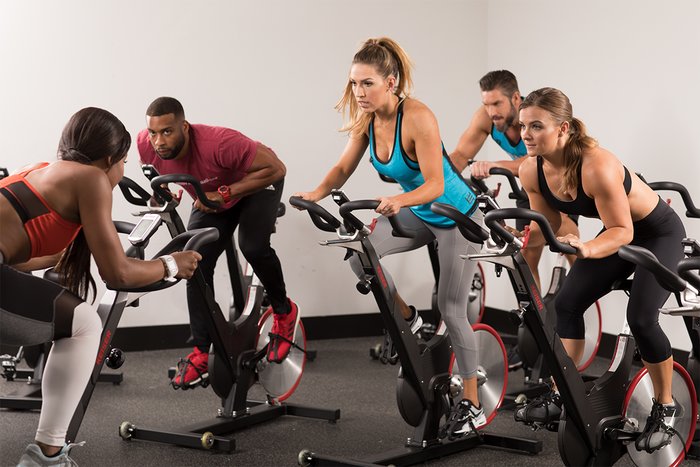You don't have to be a statistician to notice the frequent failure of New Year's fitness resolutions. Droves of people hit the gyms hard in January only to go soft soon thereafter. It's a running joke at most gyms: Make it past the post-holiday rush, and come February, you'll have the whole place to yourself for about a year.
This year, set a goal that's realistic, accessible, and progressive, and focus on an activity you can get excited about.
1. Choose an Activity You Don't Hate
Some people love going to the gym, while some people hate it. Some people love running, and some don't. Unfortunately, people sometimes choose a particular workout because of peer pressure or obligation. Creating any kind of workout that doesn't reflect what you want to do is a recipe for burnout.
There are thousands of workout plans available in thousands of different settings and formats. You can take up boxing, work with a personal trainer, join a cycling club, sign up for a triathlon, take up skateboarding, join a powerlifting gym, start working on advanced calisthenics, or try a bootcamp. The key is to select something that legitimately interests you, and that you can commit to following through on for at least 6-8 weeks. You don't have to love the program (yet), but you shouldn't hate it.

2. Forget About Motivation
Motivation is a fickle friend; sometimes it's there, sometimes it's not. Relying on motivation to fuel your workout program is like relying on regular tires to get you through the snow: You might get there, you might not.
"Don't rely on motivation," says Ian Elwood, a certified athletic trainer and strength coach who works with the Air Force to prepare para-rescuers, those superheroes who parachute into danger zones to save downed aircrews. "You can use motivation to position yourself in the beginning of your program," he says, "but don't expect it to last. Instead, set up systems that make exercise easier to follow through on."
If you work out in the morning, put your gear next to your bed the night before so there are no obstacles between you and heading to the gym. Pre-plan your workouts, schedule them into your calendar, and set reminders to go off in the hour leading up to your workout time so you won't get caught up in something else. It is this kind of preparation, not just motivation, that mentally prepares you to exercise day after day.
And reframe how you think about exercise. When you catch yourself thinking that you don't feel like going to the gym, remind yourself that it doesn't matter what you feel. You may not feel like going to work every day, but you go. Give yourself a grownup pep talk and remind yourself that exercise isn't always exciting, but it's important, especially if you've got big goals to achieve.

3. Start Slowly
As the proverb goes, "The road to hell is paved with good intentions." If your idea of "hell" is a workout-ending injury, don't be surprised if your well-intentioned workout program helps get you there.
It's a common mistake for people to dive into new workout programs with misplaced gusto. They work out too long, too hard, and too many times per week. They follow the same program they did 20 years ago, assuming their now-older body is up to the task. Then, they fail to rest and recover appropriately, wearing down their bodies and opening themselves up to extreme soreness and injuries.

There's absolutely no reason you should end up injured, forced you to derail your workout program. You just have to be willing to ease your way into a program.
"Look at your whole week of training, " Elwood says. "Break down the sets and reps and weights you intend to lift. Then, use this formula to calculate your total weekly volume:
Total Sets x Total Reps x Weight Used for Each Exercise = Volume
If you increase this amount by more than 10 percent per week, you run the risk of injury."
If you're feeling especially tired or sore after a workout day, give yourself extra time to rest and recover. Instead of hitting the gym hard, opt for a day of hiking, foam rolling, or active stretching. You'll maintain your new habit by doing something active, but you won't exacerbate your fatigue or soreness.
4. Re-evaluate Frequently
Doing the exact same workout week after week is a problem for a few reasons. First, it's a recipe for boredom, which can trigger a decision to abandon your program. Second, repeating the same workout all the time is a good way to end up stuck on a plateau. When you stop challenging your body with new exercises, your body stops adapting. And finally, as Elwood points out, if your routine isn't balanced, and you do it over and over again, you're more likely to develop unnatural movement patterns that can lead to injury.
A rule of thumb is to switch things up every 4-6 weeks.
"Maybe the first four weeks is bodyweight exercises, the next four weeks is bands and medicine balls, followed by four weeks of weights," says John Hall, the owner of John Hall Studios. "Constant change adds balance to the body and keeps things from getting monotonous. The body responds much better when you switch up your workout routines."

5. Work with a Coach
Unless you happen to be degreed and credentialed in the sport or activity you're pursuing, chances are you don't know all you need to know. It's a tough pill to swallow, especially if you think you have a good understanding of health and fitness, but consider getting a coach.
Coaches don't come cheap, but they can help you identify areas of weakness, pre-plan your workouts and progressions, and keep you accountable. Best of all, they can teach you concepts and skills you don't already know. Even if you don't employ a coach forever, it's never a bad idea to enlist one every now and then to keep you on track and moving forward.

